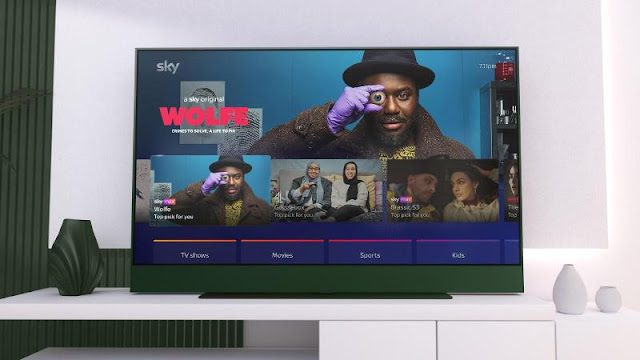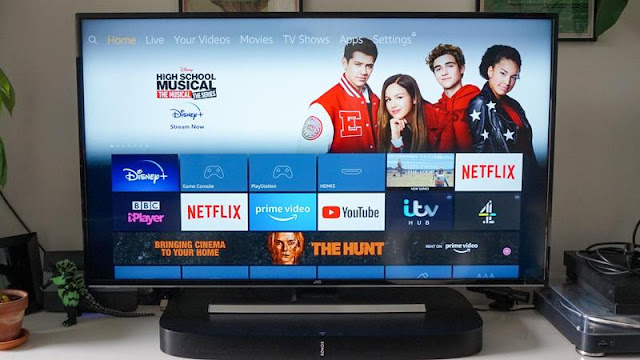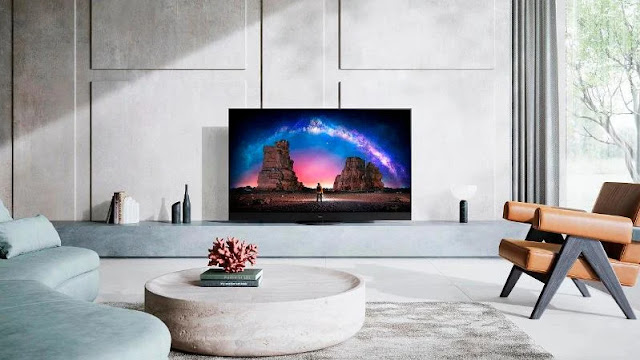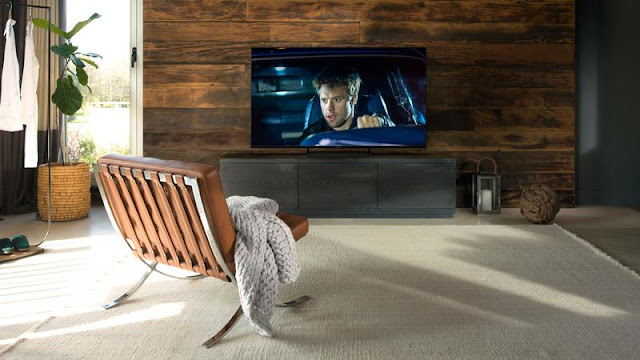Finding a new TV is not an easy task with so much jargon and techy standards to get your head around like 4K, Ultra HD, HDR and so on. Don't worry though because our smart TV guide is here to take you through everything you need to know to pick the right set.
There are various things to consider, especially when you can spend under £300 or over £2,000 on TVs that on the whole look like they offer the same thing. We've got a mix of prices here but you can check our dedicated chart of the best budget TVs if you haven't got much to spend.
Do you need OLED screen? What is Mini-LED? Should you go with Philips to enjoy Ambilight? Should you buy a TV with Roku or Fire TV software built-in? All questions you'll need to consider before hitting buy.
'Best' is subjective as it depends on what is most important to you, so we've reviewed and ranked a range of different TVs covering budget and premium prices and various features from various manufacturers including Sony, Sony, Samsung, LG, Philips and Hisense.
Remember that we can only test one size (typically 55in if we can) but specs can vary slightly between models. Note that we're adding 2022 models as and when we test them, but 2020/21 TVs are still good and discounts might mean you can pick up a bargain so check our live prices from the top retailers.
1. Philips OLED+936
- Cutting-edge OLED panel
- Brilliant Bowers & Wilkins soundbar
- 120Hz support
Cons
- Only two HDMI 2.1 ports
- No Dolby Vision IQ
- 48in not same panel
Unavailable in the US
Philips has created an outstanding all-in-one home entertainment system in the OLED+936.
Not only does it have the firm's fantastic four-sides Ambilight technology, but it also uses a next-gen OLED panel from LG for dazzling picture quality. Furthermore, there's a beefy soundbar built-in with audio from Bowers & Wilkins.
Factor that into the cost, along with the support for 120Hz gaming and this TV is hard to beat unless you really need more than two HDMI 2.1 ports and Dolby Vision IQ support.
Just note that the 48in size doesn't use the same OLED panel as the larger models.
Read our full Philips OLED+936 review
2. Samsung QN95A (2021)
- Bright Mini-LED panel
- Game Bar
- 4K 120Hz HDMI inputs
Cons
- One Connect Box is bulky
- No Dolby Vision
Mini-LED technology is here and it does not disappoint in Samsung's new Neo QLED panel.
This offers dazzling brightness along with captivating contrast and colour reproduction. It really does pop and you don't have to worry about the screenburn that OLED rivals are susceptible to.
As well as stunning picture quality, the QN95A has excellent gaming credentials with 120Hz support via four HDMI 2.1 ports and a useful Game Bar tool. The integrated Tizen interface is easy to use and give you access to a wealth of streaming content.
It's even relatively affordable at the smallest 50in size, so the main issue is the chunky One Connect Box where the benefit is only tangible when wall-mounting the TV.
Read our full Samsung QN95A review
3. LG C1 (2021)
- Dynamic, detailed image quality
- 120Hz HDMI inputs
- Game Optimizer menu
- Stylish design
Cons
- Limited webOS customisation
- Functional audio
- No HDR10+
From $1,499 | Model reviewed $2,499
The top-of-the-range G1 might have a new brighter Evo panel but the C1 doesn't really suffer by not having it.
In fact, it makes for a better value and more well-rounded package with a still brilliantly bright and detailed 4K HDR image, backed up by powerful processing, available in a range of sizes.
As well as having an excellent OLED screen, the C1 offers a sleek design, HDMI 2.1 for 120Hz gaming, low input lag and a useful Game Optimizer menu.
Gaming aside, the new webOS interface is improved - although lacking some customisation and Freeview Play is also built-in so you're set up for gaming and streaming.
Really the only downside we can find is the lack of HDR10+ support used on Amazon Prime Video.
Read our full LG C1 OLED (2021) review
4. Samsung The Frame (2021)
- Unique customisable design
- Eye-catching QLED image quality
- Tizen smart platform
Cons
- No Dolby Vision
- Unremarkable audio
Price TBC
Don't want your TV to stick out like a sore thumb? Well, The Frame is a great choice and is even better in Samsung's latest edition with a choice of bezels.
Thanks to the design and the Ambient Art Mode, you can almost forget it's a TV while not in use. Samsung's optional Art Store subscription will make it more of a feature.
It might not have Dolby Vision support or the best sound but the QLED picture quality is excellent and the Tizen smart platform provides plenty of entertainment. Just bear in mind that the smallest model is Full HD, not 4K.
Read our full Samsung The Frame (2021) review
5. LG G1 (2021)
- Brighter Evo panel
- Upgraded webOS smart platform
- 4K 120Hz HDMI inputs
Cons
- Pedestal/feet sold separately
- Unremarkable audio
- Expensive
From $2,199 | Model reviewed $2,999
If you can afford it - starting at a couple of grand for the smallest 55in size - the LG G1 is one of the best TVs you can buy in 2021.
For starters, it looks great with a 2cm uniform depth and excellent build and finish in all aspects. This really is a premium TV deserving of its flagship status. You should primarily buy it for the amazing 4K HDR picture quality, though.
With a new Evo panel for high brightness and next-gen processing, it really has the wow factor. It also boasts a new version of webOS, Freeview Play is back and best-in-class connectivity.
One of the main issues here is whether you plan to wall-mount the G1 as buying feet or the Gallery Stand costs extra. Audio performance is also nothing special.
Read our full LG G1 OLED (2021) review
6. Sky Glass
- All-in-one system
- Dolby Vision
- Amazing Dolby Atmos sound system
- No dish
Cons
- No local storage for recordings
- No Game modes or 120Hz
- No headphone support
Unavailable in the US
Sky's first own-brand TV is an interesting proposition, offering customers Sky TV without a satellite dish for the first time ever.
The TV itself is stylish, offering a choice of colours and sizes and uses a decent 4K QLED panel. You won't need a soundbar either as the Glass has a built-in Dolby Atmos sound system complete with up-firing drivers.
Buying it on a contract might be a boon for some but with no 120Hz support (despite HDMI 2.1 ports), enthusiast gamers will want to look elsewhere.
Note that this isn't just Sky Q over the internet, so the way Sky Glass works - mainly not having a hard drive to store recordings - may irk some users.
Read our full Sky Glass review
7. Samsung Q80T
- Great QLED picture
- Low latency
- Local dimming
Cons
- No Dolby Vision
From $1,099 | Model reviewed $1,299
If you want a high-end TV but don't want to empty your savings account then the Q80T offers a well-rounded balance.
This QLED model from Samsung's 2020 line-up almost has everything that the Q90T has but at a price that more people will be able to stomach.
That set might have more dimming zones and even brighter HDR but that is an unnecessary luxury for most. The Q80T is also ready for next-gen consoles for 4K gaming at 120fps.
The Q80T is a stylish set with stellar performance that'll bring your living room to life without fail.
Read our full Samsung Q80T review
8. JVC Fire TV Edition
- Very cheap
- Alexa built-in
- Decent 4K HDR picture
Cons
- Sluggish software
- Poor audio
- Limited brightness
Unavailable
JVC has partnered with Amazon to create an excellent budget TV with the Fire TV operating system built-in, so there's no need to buy a stick or box to plug-in.
It's one for the Alexa fans with even a voice-enabled remote control. The interface is better than most cheap TVs and there's plenty of app support, too, including Disney+.
All models are 4K with decent HDR support and picture quality is good for this price, but avoid the 40in size unless you're tight on space as it has weaker brightness and contrast compared to the others.
Audio isn't too bad either and you get four HDMI ports, too. Performance can be a little laggy at times, though.
Read our full JVC Fire TV Edition review
9. Panasonic JZ2000
- Stunning image quality
- Universal HDR support
- Fully immersive 3D sound
Cons
- Unapologetically pricey
- Only two HDMI 2.1 ports
Unavailable in the US
Once again, Panasonic has created an excellent TV for watching films and other content thanks mainly to a gorgeous 4K OLED panel.
It's sharp, glossy and polished without going over the top unless you choose Dynamic mode, and has been tuned by Hollywood colourist Stefan Sonnenfeld.
It's also better for gamers as unlike the HZ1000, there's HDMI 2.1 support for 120Hz on PS5 or Xbox Series X - although there are only two of these ports which is a small shame.
Watching films or gaming, the JZ2000 delivers excellent audio with a 7-channel Dolby Atmos sound system. The 360 Soundscape Pro now has side-firing speakers to provide a wider soundstage.
It's a great all-in-one home cinema proposition if you can afford it.
Read our full Panasonic JZ2000 (2021) review
10. Sony AG9
- Excellent picture
- Amazing sound
- Svelte design
Cons
- Expensive
- No HDR10+
- No low latency mode
$2,499
If you're looking for a premium Ultra HD TV then the Sony AG9 is a real standout with class-leading picture quality. This really is a stunning TV with amazing colour, contrast and localised brightness and this is despite the lack of HDR10+.
The design, as you would expect, is sleek and luxurious and having Android TV and Chromecast built-in add extra value even if loading the Android interface cuts off what you were watching. The sound is also impressive and Sony knows it since you can use the TV as an audio input.
The only issue is whether you can afford this set, even at the cheapest 55in size when there are several cheaper options out there to choose from so you'll need to consider whether you'll appreciate the difference.
4K Smart TV buying guide
4K TVs have a resolution of 3840x2160 pixels, which is exactly four times more than Full HD. You should look for a model that has several inputs – not just one – that can handle incoming 4K content sources. These can be Ultra HD Blu-ray players, games consoles and media streamers such as the Apple TV 4K and Amazon Fire TV 4K.
The key specification to look out for is HDMI version 2 input with HDCP 2.2 support. The latter is a version of copy protection used by all external 4K sources, so the more inputs that support it the better. If you buy a budget TV, it most likely will only have one HDCP 2.2-compliant input.
This means you can only connect one 4K device to the TV, which is not ideal. The prices of 4K UHD TVs have fallen dramatically, so most cost the same as HD models did a couple of years ago.
While the extra resolution that 4K offers is best appreciated on a large screen (50in or more), that hasn’t stopped smaller panels appearing. While there’s no reason not to buy a 4K TV at 40 inches, and the performance can be excellent, don’t expect to see overt picture improvements if you’re sitting the typical 8-10 feet away.
If you want 4K resolution at 120fps (or 120Hz) to make the most of the PS5 and Xbox Series X then you'll need HDMI 2.1.
All the TVs tested here have 4K resolutions. These UHD (Ultra HD) sets are the ones to buy now. Only go for a Full HD (1920x1080 pixels) set if you can't afford a 4K model or you’re buying something under 40in.
4K content is becoming more widely available with broadcasters gearing up to show a lot of sport and drama in 4K. 4K is also available over your broadband connection as long as it's quick enough.
BT also broadcasts sport in 4K (football, rugby, Moto GP, squash, to name but four) via its Infinity broadband. Because this streams at 2160/50p a much faster broadband connection is required. BT will generally refuse to offer a 4K set-top box to those Infinity customers on less than a 45Mb/s connection.
4K? What about 8K!
Just as 4K is starting to become mainstream, manufacturers are now beginning to shout about 8K. This doesn’t mean you shouldn’t buy a 4K TV.
8K broadcasts are a long way off, and there is almost no 8K content to watch. But just like 4K TVs, 8K models will upscale video so it looks sharper. But the same rules apply about screen size: you need a very, very large screen to notice the extra detail.
Unlike previous leaps in TV quality (black and white to colour, SD to HD), both 4K and 8K started off without proper, agreed standards. This is another reason why 4K is a more sensible purchase now: modern sets have the necessary H.265 support to decode broadcasts, but some early models didn’t.
You can plump for 8K now to future-proof and you'll get HDMI 2.1 by default supporting next-gen consoles, but you won't get 120fps as you'll be limited to 60Hz.
HDR
A new generation of HDR (High Dynamic Range) UHD TVs arrived in 2017 which offer higher peak whites and better colour depth than what came before. However, to appreciate these capabilities you need to feed your HDR 4K TV with HDR content, and there aren't masses around although it's on the rise.
You'll find UHD Blu-rays such as Planet Earth II, and content on Amazon and Netflix, but the rest is likely console games rather than TV shows and films. HDR comes in different standards including HDR10, HLG and Dolby Vision.
Voice commands
The Google Assistant, Bixby and Siri are assistants that originated in smartphones but are gradually finding their way into TVs.
With a voice-activated assistant onboard, you'll be able to adjust the volume and change the channel on the TV, but also control anything else within its scope, such as smart lights and heating. It's certainly a nice feature to have, but it's not a deal-breaker if it's missing.















0 comments:
Post a Comment